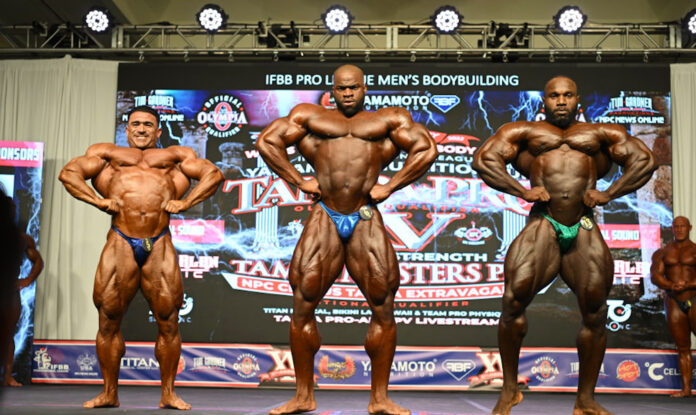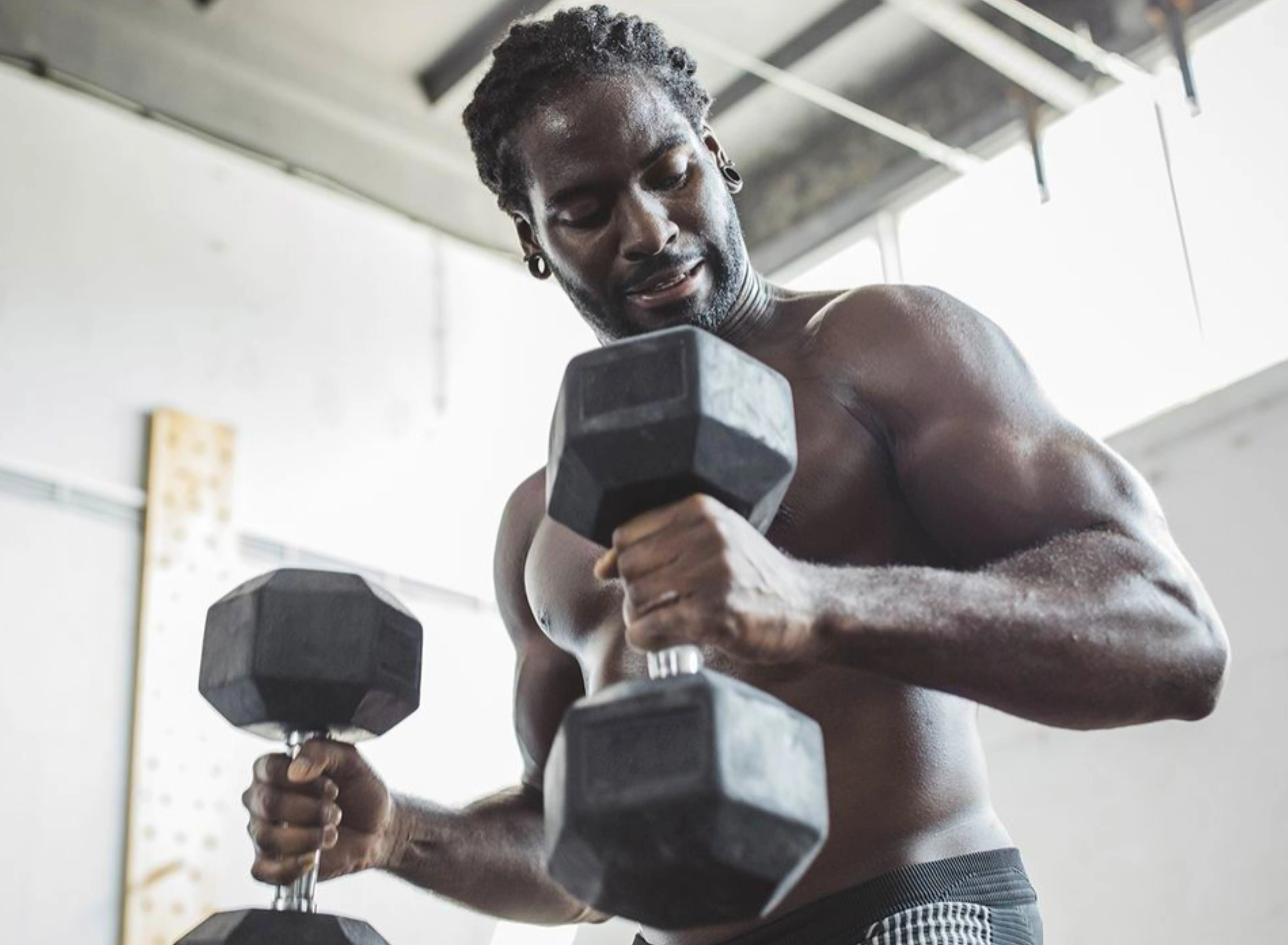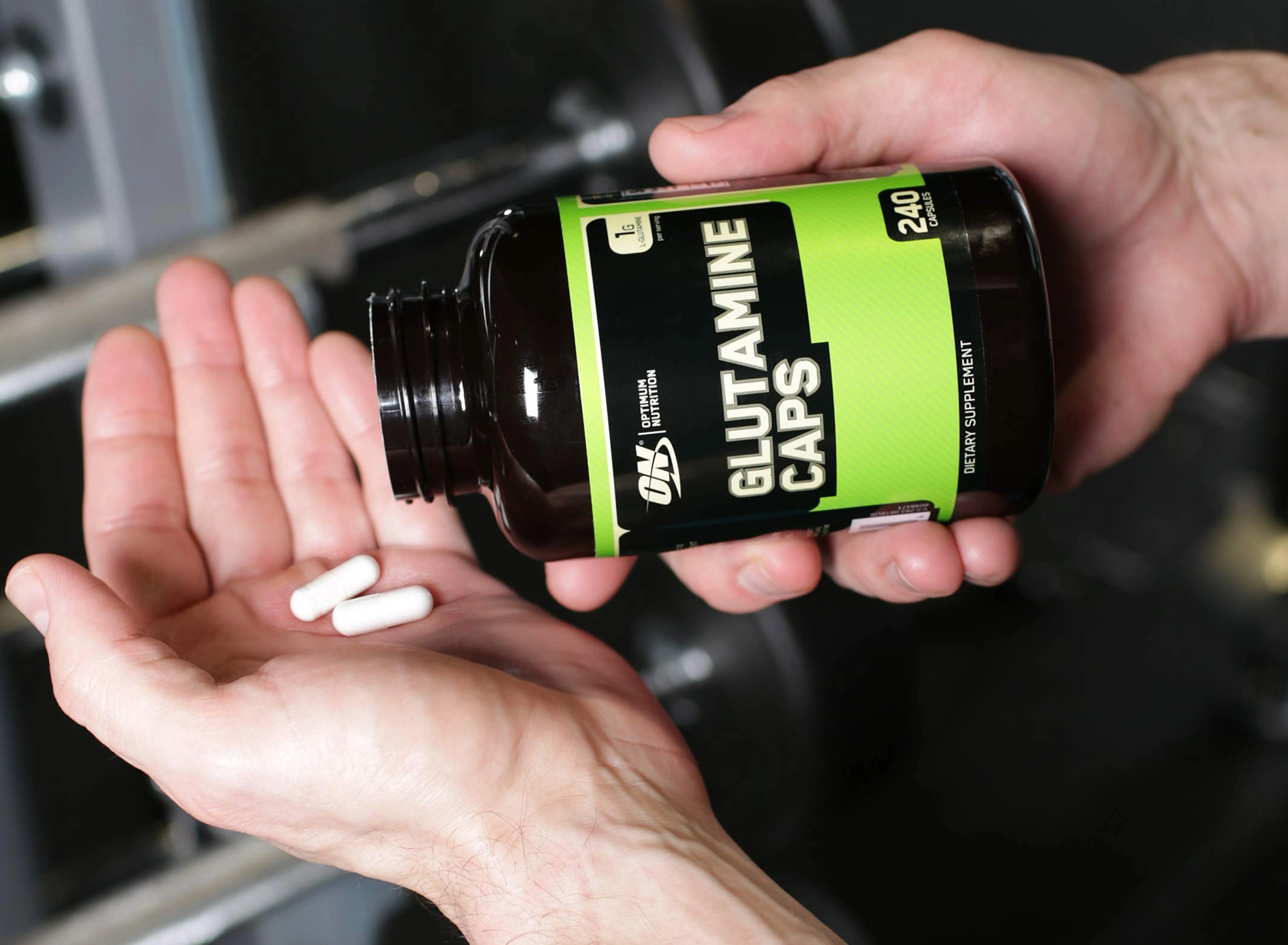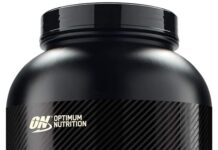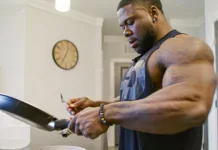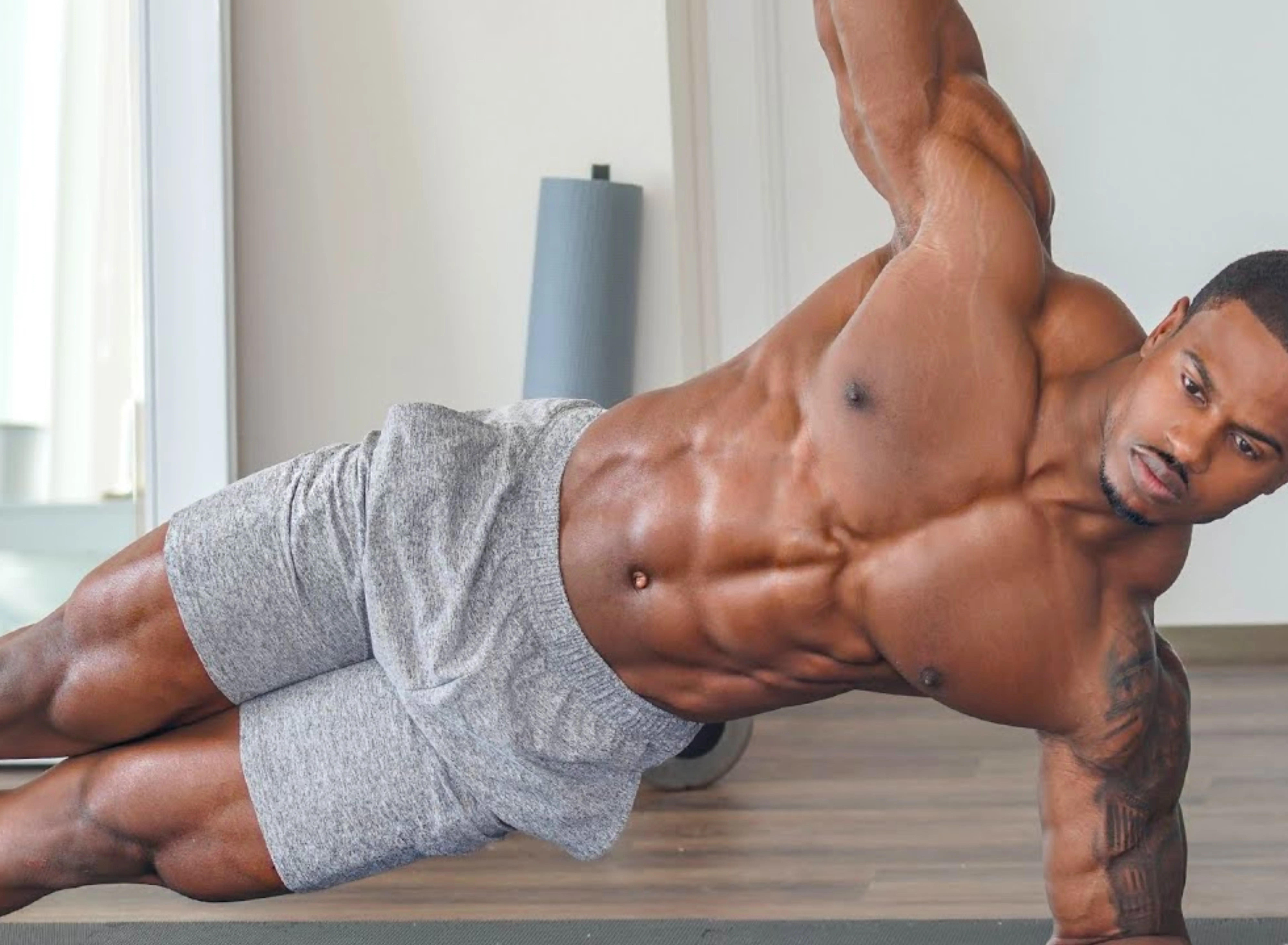Go from looking like an average Joe to ripped with these essential tips.
Building a lean, muscular physique complete with peaked biceps and a ripped midsection isn’t as easy as those 1970s movie training montages make it seem — it takes a lot of time, steadfast dedication, and sacrifice. (One thing the movies got right is that you need a killer soundtrack, especially since you’ll be at this for a while.)
Although the journey isn’t quite as glamorous as Hollywood makes it seem, it’s worth the effort. Not only will you be staring at a different person in the mirror, but you’ll also increase your metabolic rate (aka you’ll burn more calories), strengthen your bones and joints, and (possibly) decrease your risk for most diseases. (1) Some studies have also shown that packing on muscle can help your mood as well, so you’ll be feeling good on the inside and out. Who wouldn’t want all that? (2)
If you’re ready to be the next person to post an Instagram glow-up, then read through our guide that will give you everything you need to change your physique and your life.
How to Build Muscle
- Learn How Building Muscle Works
- Develop a Training Program
- Choose a Training Split
- Pick Muscle-Building Exercises
- Plan Your Sets, Reps, and Weight
- Progress Your Training
- Prioritize Sleep
- Dial-in Your Diet
- Have a Plan
How Building Muscle Works
If you’ve never picked up a dumbbell before, you might be wondering where to start to build larger pecs and a barn door back. Muscle growth is the result of three main aspects: training, recovery, and diet.
Muscle growth starts in the gym. You damage the muscle fibers with resistance training; whether that’s with your own bodyweight or heavy iron. (3) Then, your body fuses the fibers back together during the recovery period, which helps make them bigger. This is called hypertrophy, or the enlargement of muscle tissue.

Hormones in the body, such as testosterone and the human growth hormone, help muscle growth, and utilize protein to build muscle (or protein synthesis). This is where your diet comes into play. You probably already know about the importance of protein. This macronutrient is the building block of all muscles, and without it, your journey to a bigger body will come to a halt. You also need to be sure that you’re eating more calories than you are burning per day. We’ll dive into more detail on that below, however.
Food is a big part of your recovery, but so is sleep. This is when your body releases large quantities of those aforementioned hormones to repair the damage you did in the gym. You must get enough sleep to build more muscle. Again, more on that below.
Develop a Training Program
Now, you need to develop your muscle-building plan. Just as no one diet works for everyone looking to lose weight, there’s no singular training program that’s going to get everyone muscular.
Someone might prefer at-home resistance band workouts to the gym, either because the bands are easier on their joints or their job doesn’t allow them to get away for an hour-long workout. You may have a friend who does bodyweight-only workouts. All of these will work to grow your muscles when done within a program designed and, if necessary, supervised by a certified professional.
Whatever program you pick, it needs to accomplish two goals: muscle damage and muscle fatigue. Muscle damage is what we discussed before, causing damage to the muscle fibers and forcing the body to repair them, thereby making the muscles larger.
Muscle fatigue is when our body exhausts its supply of adenosine triphosphate, the cells’ preferred source of energy. In other words, whatever exercise you pick, you need to do it until your chest, back, biceps, or whatever body part you’re working out tells you, “I’m tired, and you need to stop.” You should probably listen to it.
The U.S. Department of Health and Human Services suggests people engage in muscle-building exercises at least two days a week for a total of 150 minutes (two-and-a-half hours) at a moderate-intense level, which has been backed up by independent research. (4) That said, you should consult with a certified personal trainer to come up with a workout program that works for you and your lifestyle.
Choose the Right Training Split
Typically, trainers and bodybuilders will divvy up your workouts into “splits” dedicated to a certain exercise or targeting particular body parts. Each workout split looks different and, not to sound like a broken record, can change depending on goals and time commitment.
Here are three main ones:
- Full-Body Split: You train every muscle group in one session for three days of the week, resting at least one day in between each workout. So you’ll do a full-body workout on Monday, rest Tuesday, workout again Wednesday, rest Thursday, and workout on Friday. You’ll rest for the weekend and continue over again on Monday.
- Upper-/Lower-Body Split: This workout routine targets your upper-half in one session and the lower-half in the next. On this split, you’re working out four days a week. On Monday you’ll do the upper-half, and Tuesday, you’ll hit the lower. Rest on Wednesday, and repeat that scheme Thursday and Friday. Rest on the weekend.
- Push/Pull/Legs: This is the most common approach for powerlifters and bodybuilders, as it’s the scheme with the most days in the gym and allows for maximal targeting of every muscle group. As the name suggests, you’ll be doing pushing movements on the first day (bench press, lateral raises, triceps pushdowns), pulling movements the next (deadlifts, rows, pull-ups), and legs on the third day (squats and lunges). You’ll typically do push, pull, legs, push, pull, legs, and then rest before washing, rinsing, and repeating.

There are other splits, and some people even dedicate just one or two days a week to working out, and it works out for them (pun intended).
Pick Your Muscle-Building Exercises
Once you know your workout split, you need to figure which exercises you want to do. Create some way to track your program, whether that’s a note on your iPhone, a Google Doc, or even an old fashioned journal. Then, write out columns for each of your training days. Of course, these will change depending on your split, but we’re going to stick with the full-body split for this example.
First, you want to identify how many exercises for each muscle you’re going to do. Because you’re hitting every major muscle in your body in one session, the workload can add up fast, so be conservative. For larger muscles, like your chest, legs, and back, we suggest two exercises per session. For your other muscles (shoulders, biceps, triceps, calves, and forearms), stick to one exercise each. Also, be sure to pick a different exercise per muscle for each of your three weekly full-body workouts. Otherwise, you’ll get bored — fast.
As for what exercises to pick, that’s really up to you. However, a general rule to follow is to start with a heavier compound movement — such as the back squat or deadlift — and then work isolation exercises such as curls and skull crushers. Compound movements (which mean exercises that engage more than one joint) are more taxing, so you want to do them first to avoid fatigue. Deadlifting after a bunch of curls, lateral raises, and calf raises won’t be as effective. You’ll be beaten. One important note: Do not pack each of your three full-body days with hard compound movements. Deadlifting, squatting, and bench-pressing one day isn’t impossible, but ill-advised. Especially if you’re a beginner. We suggest starting one of your three workouts with one of those moves and then picking less taxing exercises for the remainder of the workout. So, one day you’d start with the deadlift, then the bench press, and then the back squat.
With all that said, here’s an example of how one day of full-body training can look like:
Example Full-Body Split
- Back: Deadlift, four sets of eight reps.
- Quads: Goblet Squat, four sets of eight to 10 reps.
- Chest: Dumbbell Bench Press, four sets of 10 reps.
- Hamstrings: Lying Leg Curl, three sets of 12 reps.
- Back: Lat Pulldown, three sets of 12 reps.
- Chest: Cable Chest Flye, three sets of 12 reps.
- Quads: Leg Extensions, two sets of 20 reps.
- Shoulders: Dumbbell Overhead Press, 3 sets of 10 reps.
- Biceps: Hammer Curl, three sets of 12 reps.
- Triceps: Triceps Pushdown, three sets of 12 reps.
- Calves: Calf Raise, three sets of 15 reps.
Plan Your Sets, Reps, and Weights
When you pick a workout split that works for you, you’ll next need to determine how much of each move you should do (known as reps) and how heavy you’ll want to go (if you’re lifting weights). Your personal trainer will work with you to decide your rep/set scheme, but generally speaking, it will depend on how often you’re working out.
For example, if you’re only hitting the gym twice a week, you’re going to have to pump more total sets and reps per session than someone who’s hitting the gym six days a week. It should be noted that sets and reps are simply a practical way to measure the amount of time-under-tension (TUT) that your muscle is under per set. TUT is what dictates your overall muscle damage. As you advance through your training, you may stumble upon people or articles that talk about tempo training, which is when you perform a fewer number of reps for a longer period of time. This is a great tool meant to prolong TUT. But for now, we suggest sticking with standard-speed reps.
To achieve optimal TUT for muscle growth, you should aim to perform anywhere from eight to 12 reps. As for how much you should lift, that answer changes person-to-person. However, a great rule of thumb is to choose a weight that has you failing two reps past whatever your target rep count is. So, if you want to curl for sets of eight, choose a weight that has you failing at 10. This ensures that you’ll be able to make it through all of your settings for that exercise.
Speaking of sets, you’re probably wondering how many you should do. The best way to figure this out is to look at total volume. For bigger muscles (chest, back, and legs), you’ll want to start by accumulating 15-20 total sets per week. For small muscles (arms, shoulders, abs, and calves), aim for 10 total weekly sets. Depending on your split, you’ll then break up those sets evenly across workouts. For example, say you have two pulling workouts per week, you’ll divide your total sets for your back, biceps, and hamstrings across two workouts.
How to Progress
This brings us to progression. There will be a time when a dumbbell that once felt like Thor’s hammer will seem like a feather to you — if you’ve stayed committed to your workouts, that is. When this happens, you need to do one of two things: lift that weight for more reps or lift heavier weights. If you don’t, the muscle fibers won’t get damaged to the point where they’ll grow, and you’ll hit a plateau. Simple, right?
There are other ways to progress, but we suggest sticking with a basic rep and weight progression. Pick a rep range (say, 8-12), and start at the bottom of that range with a particular weight. Each workout, you’ll do one more rep with that same weight until you hit the top end of your range. Once you’re at the top end, you’ll add a small amount of weight (two-and-a-half to five pounds) and start back at the low-end of the range. If you did create a Google Doc or keep a workout journal (per our suggestion above), then write down the weight you lifted and for how many sets and reps. This way, you’ll know exactly when you need to add more weight.
Sleep it Off
We’ve already alluded to it, but here’s a fact many people need to hear: muscles aren’t made in the gym. They’re made in the bedroom. OK, it’s a little more complicated than that but remember when we said muscles become bigger when the body repairs the fibers that were broken down during training? That can’t happen if you’re constantly working out. A car needs pit stops during a cross-country trip, and your body needs sleep and food on any physique-changing quest.
Studies have shown that testosterone and HGH — the type your body makes naturally — are at their peak when we get a good night’s sleep and decrease when we have low-quality Zs. (5) These hormones aid the body in repairing muscle fibers and growing muscle tissue. It won’t be a Sleeping Beauty case, though. You’re not going to wake up one morning looking like Arnold Schwarzenegger in his prime. You’ll have to remain committed to getting a solid seven to nine hours of sleep each night.
Also, try to remove any stressors in your life, whether that be a partner you’ve been meaning to break up with or quitting a job you hate. (You should maybe do those things for reasons beyond muscle gain, but we’re going to stay in our lane here.) Hormones released by the body during stress have been shown to impact muscle growth negatively — so if you’re always under duress, you’re going to have a harder time than someone who’s happy-go-lucky. (6)
Lastly, they’re called rest days for a reason. You should be resting, not doing “a light workout” on that day. Go for a walk or sit on the couch and binge some Netflix.
Dial-in Your Diet
We’ve already covered the importance of protein, and odds are you probably know a gym bro who’s been telling you to eat a scoop of protein powder with every meal. Don’t do that, but protein is crucial to your gains. Protein helps build muscles and make them stronger, as do the amino acids in protein-rich foods.
Another advantage of protein? Unlike carbs and fats, it can’t be stored in the body and turned into fat. Even sedentary people can eat up to two grams of protein per kilogram of body weight with no adverse effects.
Additionally, protein speeds up the thermic effect of feeding — that is, the number of calories your body burns digesting food. You heard that right. You’re actually burning calories just by digesting your food, and protein is your best friend when it comes to that.
The quality of protein is equally as important. Just because something says it has 20 grams of protein in it, that doesn’t mean you’re getting that much. For example, vegetable-based proteins from a Beyond Burger aren’t as bioavailable as the protein from a skirt steak. Simply put: your body can’t absorb the protein from the veggie-based options as effectively as the animal-based ones.
Another disadvantage of veggie-based proteins is their lack of essential amino acids, which form protein molecules. There are nine essential amino acids, meaning they aren’t made in the body and must be obtained through your diet. Animal-based proteins have all of them, whereas veggie-based proteins only have some.
To get around this problem, vegans and vegetarians should make sure they’re eating complementary amino acids. For example, beans are a good source of protein, but they lack the amino acid methionine. Methionine is found in rice, though, so by eating beans and rice together, you’re getting all your amino acids.
You’ll need to be eating more than protein, though, and as we touched on before, you’ll need to eat more food than you typically have been. How much?
First, you’ll need to figure out how many calories you need to maintain your weight. From there, you’ll want to add 100 to 300 additional calories each day. Doing it this way helps you gain weight, but mostly the good kind (aka muscle). Eating any more than that is likely to make you fatter instead of muscular. Also, you’ll want to figure out your exact macronutrient breakdown, too. Your overall calories dictate whether you gain or lose weight, but your specific macro ratios (macros meaning protein, carbs, and fats, which make up your calories) will determine whether you gain muscle and/or lose fat. For that reason, we suggest taking your diet one step further and counting your macros (it’s as hard as it sounds).
How to Proceed
This is a lot of info to process, and it’s understandable if you’re a little overwhelmed. Gaining muscle takes time, dedication, and hard work — but it is not rocket science. Here’s a list of actionable steps you can take
- Develop a training plan by first deciding how often you want to workout out, then choose a workout split.
- Write down the exercises you’re going to do each day.
- Now, decide how many sets and reps you’re going to do for each exercise. Remember that eight to 12 reps are a great starting rep range to accumulate optimal time-under-tension.
- Be sure that you’re progressing each workout. If you can’t manage to add a rep to your lift, that’s ok. Simply repeat that week until you get it.
- Prioritize sleep. You won’t grow optimally or feel good if your sleep is poor. Aim for seven to nine hours.
- Make sure your diet is tight. Calculate your calories, then your macros, and eat just slightly above your maintenance level to avoid gaining too much fat.
More Muscle-Building Tips
Now that you have the know-how put that knowledge to the test by reading through some of our handy workout guides.
- Robert R Wolfe, The underappreciated role of muscle in health and disease, The American Journal of Clinical Nutrition, Volume 84, Issue 3, December 2006, Pages 475–482, https://doi.org/10.1093/ajcn/84.3.475
- Moon JH, Kong MH, Kim HJ. Low Muscle Mass and Depressed Mood in Korean Adolescents: a Cross-Sectional Analysis of the Fourth and Fifth Korea National Health and Nutrition Examination Surveys. J Korean Med Sci. 2018;33(50):e320. Published 2018 Nov 19. doi:10.3346/jkms.2018.33.e320
- Schoenfeld BJ. The mechanisms of muscle hypertrophy and their application to resistance training. J Strength Cond Res. 2010 Oct;24(10):2857-72. doi: 10.1519/JSC.0b013e3181e840f3. PMID: 20847704.
- O’Donovan G, Lee I, Hamer M, Stamatakis E. Association of “Weekend Warrior” and Other Leisure Time Physical Activity Patterns With Risks for All-Cause, Cardiovascular Disease, and Cancer Mortality. JAMA Intern Med. 2017;177(3):335–342. doi:10.1001/jamainternmed.2016.8014
- O’Donovan G, Lee I, Hamer M, Stamatakis E. Association of “Weekend Warrior” and Other Leisure Time Physical Activity Patterns With Risks for All-Cause, Cardiovascular Disease, and Cancer Mortality. JAMA Intern Med. 2017;177(3):335–342. doi:10.1001/jamainternmed.2016.8014
- Poornima KN, Karthick N, Sitalakshmi R. Study of the effect of stress on skeletal muscle function in geriatrics. J Clin Diagn Res. 2014;8(1):8-9. doi:10.7860/JCDR/2014/7014.3966
